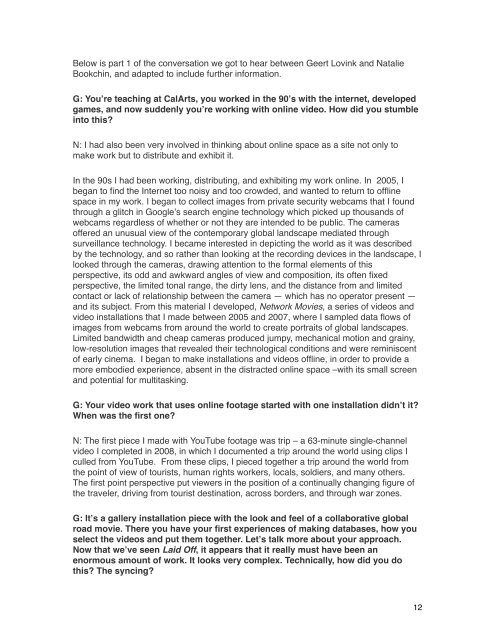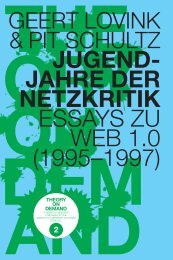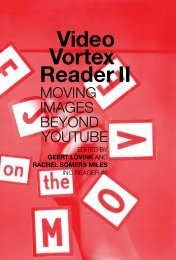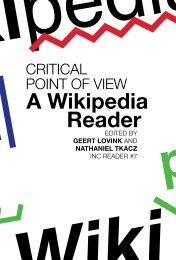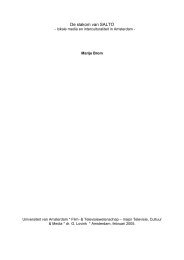Download PDF - Institute of Network Cultures
Download PDF - Institute of Network Cultures
Download PDF - Institute of Network Cultures
Create successful ePaper yourself
Turn your PDF publications into a flip-book with our unique Google optimized e-Paper software.
Below is part 1 <strong>of</strong> the conversation we got to hear between Geert Lovink and Natalie<br />
Bookchin, and adapted to include further information.<br />
G: Youʼre teaching at CalArts, you worked in the 90ʼs with the internet, developed<br />
games, and now suddenly youʼre working with online video. How did you stumble<br />
into this?<br />
N: I had also been very involved in thinking about online space as a site not only to<br />
make work but to distribute and exhibit it.<br />
In the 90s I had been working, distributing, and exhibiting my work online. In 2005, I<br />
began to find the Internet too noisy and too crowded, and wanted to return to <strong>of</strong>fline<br />
space in my work. I began to collect images from private security webcams that I found<br />
through a glitch in Googleʼs search engine technology which picked up thousands <strong>of</strong><br />
webcams regardless <strong>of</strong> whether or not they are intended to be public. The cameras<br />
<strong>of</strong>fered an unusual view <strong>of</strong> the contemporary global landscape mediated through<br />
surveillance technology. I became interested in depicting the world as it was described<br />
by the technology, and so rather than looking at the recording devices in the landscape, I<br />
looked through the cameras, drawing attention to the formal elements <strong>of</strong> this<br />
perspective, its odd and awkward angles <strong>of</strong> view and composition, its <strong>of</strong>ten fixed<br />
perspective, the limited tonal range, the dirty lens, and the distance from and limited<br />
contact or lack <strong>of</strong> relationship between the camera — which has no operator present —<br />
and its subject. From this material I developed, <strong>Network</strong> Movies, a series <strong>of</strong> videos and<br />
video installations that I made between 2005 and 2007, where I sampled data flows <strong>of</strong><br />
images from webcams from around the world to create portraits <strong>of</strong> global landscapes.<br />
Limited bandwidth and cheap cameras produced jumpy, mechanical motion and grainy,<br />
low-resolution images that revealed their technological conditions and were reminiscent<br />
<strong>of</strong> early cinema. I began to make installations and videos <strong>of</strong>fline, in order to provide a<br />
more embodied experience, absent in the distracted online space –with its small screen<br />
and potential for multitasking.<br />
G: Your video work that uses online footage started with one installation didnʼt it?<br />
When was the first one?<br />
N: The first piece I made with YouTube footage was trip – a 63-minute single-channel<br />
video I completed in 2008, in which I documented a trip around the world using clips I<br />
culled from YouTube. From these clips, I pieced together a trip around the world from<br />
the point <strong>of</strong> view <strong>of</strong> tourists, human rights workers, locals, soldiers, and many others.<br />
The first point perspective put viewers in the position <strong>of</strong> a continually changing figure <strong>of</strong><br />
the traveler, driving from tourist destination, across borders, and through war zones.<br />
G: Itʼs a gallery installation piece with the look and feel <strong>of</strong> a collaborative global<br />
road movie. There you have your first experiences <strong>of</strong> making databases, how you<br />
select the videos and put them together. Letʼs talk more about your approach.<br />
Now that weʼve seen Laid Off, it appears that it really must have been an<br />
enormous amount <strong>of</strong> work. It looks very complex. Technically, how did you do<br />
this? The syncing?<br />
12


